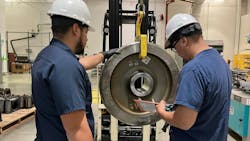WMATA begins repairing 7000-series railcar wheels under new process
The Washington Metropolitan Area Transit Authority (WMATA) has begun replacing the wheels on all 7000-series railcars under new, higher standards that will allow WMATA to resume regular maintenance intervals and gradually add more 7000-series railcars to service. The first of the repaired railcars went into passenger service on Dec. 4.
Under the new process, with concurrence from the Washington Metrorail Safety Commission (WMSC), WMATA will increase the fit and press tonnage used to mount the wheels to the axles on the railcar.
After 20,000 miles in passenger service, WMATA will perform additional inspections, wheel measurements and engineering analysis on the railcars before the 7000-series railcars return to the standard periodic inspection intervals.
“We appreciate the tireless efforts of our safety and maintenance teams to develop this process to ensure we can safely return more 7000-series railcars to service, which are the newest and most reliable in our railcar fleet,” said WMATA General Manager and CEO Randy Clarke. “It will take an extensive amount of work during the next few years but as we begin to have more 7K’s available, customers will begin to see even more improvements in reliability and service.”
Due to the 7000-series railcar shortage, WMATA continues to utilize its oldest, least reliable railcars in the legacy fleet. As more 7000-series railcars are completed, tested and able to run longer between inspection intervals, WMATA will gradually be able to increase the number of 7Ks in service, providing customers with more reliability and comfort, allowing WMATA to eventually remove the older, legacy railcar fleet placed into service.
According to WMATA, pressing the wheels is an exhaustive process that requires 72 hours of work for each pair of railcars. Unlike changing the tires on a car, the entire wheel assembly or truck, including the axle, frame and two wheels, must be removed from the railcar, similar to removing the entire front end of a vehicle. The wheels must be disassembled from the truck and new wheels with a tighter fit installed at an increased force onto the axle before being reassembled onto the railcar.
The work requires specialized equipment, customized and calibrated to WMATA-specific production requirements and involves significant training to perform. After the wheels are pressed, the railcars undergo up to 30 hours of detailed inspections before going into passenger service. During the follow-up engineering analysis, the wheelsets must be removed from the railcars and taken apart for additional inspection and testing.
Under the current return to service plan, WMATA continues to inspect 7000-series railcars at 30-day intervals, limiting the number of 7000-series railcars that can operate due to the frequency of inspections.
Once the wheel pressing process and training ramps up, WMATA expects to complete approximately 20 cars a month. With 748 railcars, including 5,984 wheels on 2,992 axles, it is expected to take several years to return the entire fleet to normal service at an estimated cost of $55 million.
WMATA developed the plan to press wheels on the 7000-series fleet at a higher standard following extensive engineering and data analysis and based on a technical report issued by the National Transportation Safety Board citing engineering experts, who identified a technical issue -- microslip due to reduction in contact pressure – as a factor in the 7000-series railcars wheel migration issue.
